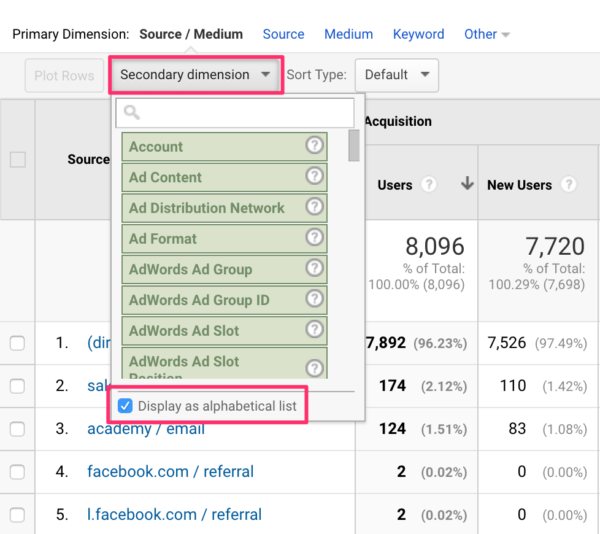Improve Your Metrics: Understanding Google Analytics Secondary Dimension
Wiki Article
Unlocking the Power of Second Dimension Analytics for Boosted Data Insights and Decision-Making
In the world of data analytics, main dimensions typically take the spotlight, but the true depth of understandings exists within the world of additional dimensions. By utilizing the power of additional dimension analytics, organizations can introduce surprise fads, discover connections, and extract more meaningful verdicts from their information.
Importance of Second Measurements
Checking out the importance of secondary measurements in analytics reveals the covert layers of data understandings critical for notified decision-making in different domains. Second measurements give a deeper understanding of primary data by supplying additional context and viewpoints. By incorporating secondary dimensions into analytics, companies can extract extra detailed and nuanced understandings from their datasets.One trick significance of secondary measurements is their ability to section and categorize main data, enabling an extra thorough analysis of details subsets within a dataset. This segmentation makes it possible for businesses to recognize patterns, fads, and outliers that could not be obvious when checking out the information as a whole. Secondary dimensions aid in uncovering correlations and dependencies in between various variables, leading to more exact forecasting and anticipating modeling - secondary dimension.
Moreover, additional measurements play a critical duty in boosting information visualization and reporting. By including second dimensions to visualizations, such as graphes or charts, analysts can develop much more informative and helpful depictions of information, facilitating better interaction of searchings for to stakeholders. On the whole, the combination of secondary measurements in analytics is critical in unlocking the complete capacity of information and driving evidence-based decision-making.
Key Advantages of Utilizing Second Dimensions
Using secondary measurements in analytics provides companies a tactical benefit by augmenting the deepness and granularity of information insights. One vital advantage of integrating secondary dimensions is the capacity to segment and filter information, permitting a much more detailed analysis of particular aspects within a dataset. This division makes it possible for companies to acquire an extra nuanced understanding of their audience, performance metrics, and various other vital data points. By dissecting data using second measurements such as time, location, device kind, or user demographics, companies can discover patterns, trends, and correlations that may or else remain surprise.Moreover, the application of second dimensions enhances the context in which primary data is interpreted. It gives a more detailed view of the partnerships in between different variables, allowing organizations to make educated choices based upon a more holistic understanding of their data. Additionally, additional dimensions promote the recognition of outliers, abnormalities, and locations for optimization, inevitably bring about extra efficient methods and enhanced outcomes. By leveraging additional measurements in analytics, companies can harness the full capacity of their information to drive much better decision-making and accomplish their service goals.
Advanced Data Evaluation Methods
A deep dive into advanced data evaluation methods reveals sophisticated techniques for drawing out important understandings from intricate datasets. One such method is artificial intelligence, where algorithms are utilized to identify patterns within data, predict results, and make data-driven decisions. This technique enables the automation of logical design structure, enabling the handling of large volumes of data at a faster pace than typical techniques.Another advanced strategy is anticipating analytics, which uses analytical algorithms and machine learning techniques to forecast future end results based upon historical data. By examining patterns and patterns, services can prepare for client site link behavior, market trends, and possible dangers, equipping them to make positive decisions.
Additionally, message mining and view evaluation are beneficial techniques for drawing out understandings from disorganized information sources such as social media remarks, client evaluations, and survey reactions. By assessing message information, organizations can understand consumer point of views, identify emerging trends, and improve their solutions or products based on feedback.
Enhancing Decision-Making With Second Dimensions

Enhancing decision-making with second measurements makes it possible for services to make even more educated and targeted strategic choices. By segmenting customer information based on secondary measurements like buying history or involvement degrees, business can customize their marketing approaches to certain target market segments, leading to boosted conversion prices and consumer contentment. Second measurements can help determine relationships and partnerships between different variables, allowing organizations to make data-driven choices that drive development and earnings.
Implementing Second Measurement Analytics
When including secondary measurements in analytics, organizations can unlock much deeper insights that drive calculated decision-making and boost total performance. Applying secondary measurement analytics requires an organized method to guarantee effective utilization of this effective device. The initial step is to recognize the vital metrics and dimensions that line up with the company's strategic objectives. This involves understanding the particular concerns the organization seeks to address and the data factors needed to resolve them.
Furthermore, organizations ought to utilize progressed analytics tools and technologies to improve the process of incorporating secondary dimensions. These devices can automate data processing, analysis, and visualization, enabling organizations to focus on interpreting understandings instead of manual data adjustment.
Final Thought
In verdict, secondary dimension analytics play a crucial role in improving information understandings and decision-making processes. By making use of innovative data analysis strategies and applying additional measurements efficiently, organizations can open the power of their data to drive critical company choices. The crucial advantages of making use of second measurements can not be overemphasized, as they offer a deeper understanding of information patterns and connections. It is crucial for companies to take advantage of secondary measurement analytics to look at here now stay affordable in today's data-driven landscape.In the world of information analytics, main measurements commonly take the spotlight, however the true deepness of understandings lies within the realm of secondary measurements.Making use of second measurements in analytics provides organizations a tactical benefit by increasing the deepness and granularity of information insights. By leveraging secondary dimensions in analytics, companies can harness the full possibility of their data to drive far better decision-making and attain their business goals.
Executing data recognition procedures and regular audits can assist keep information quality and reliability.
By using sophisticated data evaluation methods and applying secondary measurements properly, companies can open the power of their information to drive strategic service choices.
Report this wiki page